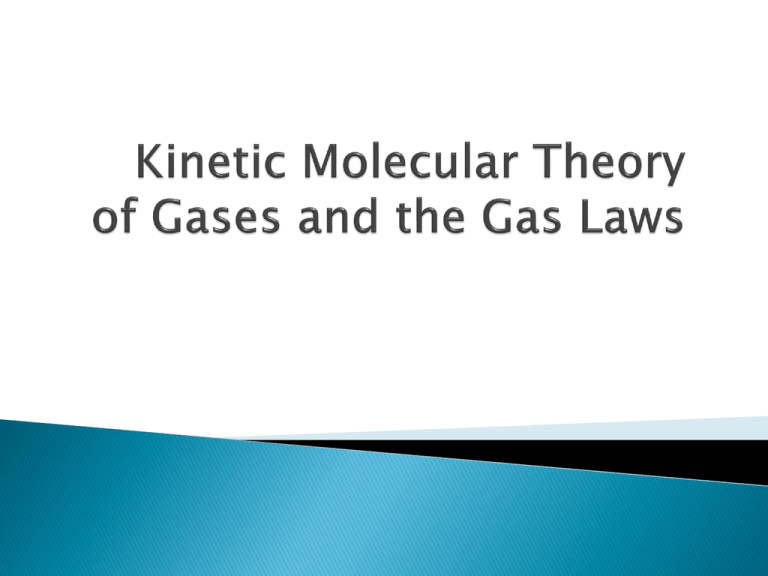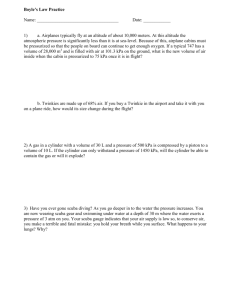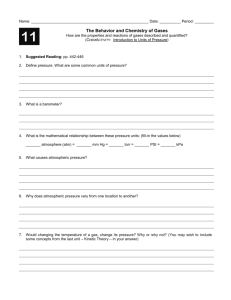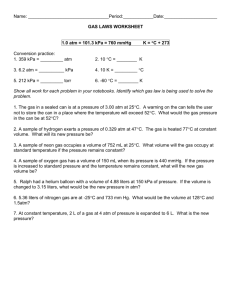Kinetic Molecular Theory of Gases and the Gas Laws
advertisement

Gases are fluids ◦ Fluids are any substance that flows Gases are highly compressible ◦ Example: Tire pressure Gases completely fill containers Gases have lower densities than liquids and solids KMT describes the motion of the particles ◦Particles have the same motion as billiard balls http://intro.chem.okstate.edu/NSFCCLI /GasLaw/GLP.htm ◦ ◦ ◦ ◦ Assumptions: Gas molecules are in constant, random motion Gas molecules are separated by large distances Gas molecules have no attractive/repulsive forces Collisions are considered to be perfectly elastic ( no energy is lost ) Temperature and energy of gases are directly proportional ◦ As the temperature increases, kinetic energy of the molecules increases ◦ As temperature decreases, kinetic energy will also decrease At sea level, the standard gas pressure is 1 atmosphere Pressure is the force exerted by gas molecules Standard Temperature and Pressure (STP) is equal to 1 atm and 0 °C. Note:1 ATM is measured from the surface of the ocean (sea level) to the top of the sky (stratosphere) Atmosphere ( atm) Torr / millimeter of mercury mm Hg Pounds per square inch (psi) Pascal of kilo Pascal (Pa or kPa) Conversions vs. 1 ATM 760 mm Hg or Torr 14.7 psi 101.325 kPa Convert 72.7 atmospheres (atm) into kilopascals (kPa) Convert 31.2 psi to ATM Variables in Gas Equations: ◦P = Pressure (kPa or atm) ◦V = Volume (L) ◦T = Temperature (K) ◦n = amount of gas (moles) States that for a fixed amount of gas at constant temperature the volume of the gas is inversely proportional to the pressure of a gas Pressure Volume P1V1 P2V2 Example Problem ◦ The pressure on 2.50 L of anesthetic gas changes from 105 kPa to 40.5 kPa. What will be the new volume if the temperature remains constant? Example Problem ◦ A high-altitude balloon contains 30.0 L of helium gas at 103 kPa. As the balloon rises, you record a new volume of 35.0 L. What is the atmospheric pressure in kPa? (Assume constant temperature) States that the volume of a gas is directly proportional to the Kelvin temperature if the pressure remains constant Temperature V1 V2 T1 T2 Volume Example Problem ◦ The air in a hot air balloon has a volume of 400.0 L at 30.0°C (303 K). What will the volume be if the temperature is raised to 120.0 °C (393 K)? Example Problem ◦ An aerosol can has a volume of 3.00 x 102 mL at 150.0°C is heated until its volume is 6.00 x 102 mL. What is the new temperature (in K) of the gas if pressure remains constant? States that the pressure of a gas is directly proportional to the Kelvin temperature if the volume remains constant Temperature Pressure P1 P2 T1 T2 Example Problem ◦ The gas left in a used aerosol can is at a pressure of 103 kPa at 25 °C. If this can is thrown onto a fire, what is the pressure of the gas when its temperature reaches 928 °C? Example Problem ◦ A sealed cylinder of gas contains nitrogen gas at 1.00 x 103 kPa pressure and a temperature of 20.0 °C. The cylinder is left in the sun, and the temperature of the gas increases to 50.0 °C. What is the new pressure in the cylinder? A single equation that combines all the gas laws: Example Problem ◦ A gas takes up a volume of 17 liters, has a pressure of 2.3 atm, and a temperature of 299 K. If I raise the temperature to 350 K and lower the pressure to 1.5 atm, what is the new volume of the gas? Relates the gas laws and the amount of gas Requires the gas constant, R ◦ R can be a different number depending on the units kPa L R 8.31 mol K atm L R 0.08205 mol K Example Problem ◦ A container of 3.0 L of nitrogen (N2) is at a pressure of 4.5 x 102 kPa and a temperature of 39 °C. How many grams of N2 are in the container? Example Problem ◦ What pressure will be exerted by 0.450 mol of a gas at 25.0 °C if it is contained in a 0.650 L vessel? Equal volumes of gases at the same temperature and pressure contain equal numbers of particles Due mainly to the large amount of empty space between particles ◦ From this, scientists have determined that 1 mol = 22.4 L at STP Why? ◦ Tennis balls vs. Bowling balls









